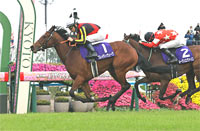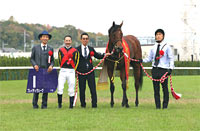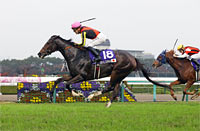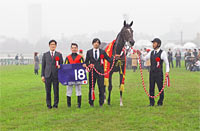Queen Elizabeth II Cup (G1) - Data Analysis
The champion filly & mare decider - birthplace of many future stars
Of the seven winners since 2009, only Meisho Mambo in 2013 had prior experience of competing in the JRA filly classics (Oka Sho and Oaks). In both 2010 and 2011, the winner was the Great Britain-trained Snow Fairy; last year’s winner Marialite had no previous experience of winning an open class contest and had never before entered a G1 race. In recent years, the Queen Elizabeth II Cup has been notable for the emergence of newcomers with no track record on the domestic G1 circuit for fillies. This time, let’s analyze features shared by successful runners in this race, based on race results over the last 10 years.
Check the finish and race condition last time out
Of 30 Top 3 finishers over the last 10 years, 18 had finished “In the Top 3” in their previous outing. By contrast, horses finishing “4th or lower” last time out have tended to struggle, with a Top 3 ratio of only 12.2%. When comparing the runners’ pre-race buildup, a good finish in the previous race should be taken at face value. [Table 1]
[Table 1] Performance by finish last time out (last 10 years)
| Finish last time out |
Performance
[1st-2nd-3rd-4th or lower] |
Win ratio |
Top 2 ratio |
Top 3 ratio |
| In the Top 3 |
5-7-6-53 |
7.0% |
16.9% |
25.4% |
| 4th or lower |
5-3-4-86 |
5.1% |
8.2% |
12.2% |
Moreover, of those finishing “In the Top 3” last time out, performances have been even better when the race in question was a “JRA or overseas graded race”; fillies in this category have achieved a Top 3 ratio of 34.0%. Runners coming straight from success in a graded race deserve a high evaluation here. [Table 2]
[Table 2] Performance of horses finishing "In the Top 3" in their previous race, by the condition of that race (last 10 years)
| Condition of previous race |
Performance
[1st-2nd-3rd-4th or lower] |
Win ratio |
Top 2 ratio |
Top 3 ratio |
| JRA or overseas G-races |
5-6-5-31 |
10.6% |
23.4% |
34.0% |
| Other races |
0-1-1-22 |
0% |
4.2% |
8.3% |
Again, of those finishing “4th or lower” last time out, superior performances have been achieved here when the condition of the race in question was a “JRA or overseas G1 or G2 race except fillies and mares races.” Horses in this category have a Top 3 ratio of 37.5%. So it seems that, even if the previous race ended in failure, we can disregard that result if the race in question was a G1 or G2 race except fillies and mares races. [Table 3]
[Table 3] Performance of horses finishing "4th or lower" in their previous race, by the condition of that race (last 10 years)
| Condition of previous race |
Performance
[1st-2nd-3rd-4th or lower] |
Win ratio |
Top 2 ratio |
Top 3 ratio |
| JRA or overseas G1 / G2 races except fillies and mares races |
3-2-1-10 |
18.8% |
31.3% |
37.5% |
| Other races |
2-1-3-76 |
2.4% |
3.7% |
7.3% |
Younger fillies come out on top
Of 30 Top 3 finishers over the last 10 years, 23 were aged “4 and under.” On the other hand, those aged “5 and up” have tended to struggle, with a Top 3 ratio of 10.6%. When comparing fillies by age, it would seem wise to go for the younger ones. [Table 4]
[Table 4] Performance by age (last 10 years)
| Age |
Performance
[1st-2nd-3rd-4th or lower] |
Win ratio |
Top 2 ratio |
Top 3 ratio |
| 3 |
5-4-3-41 |
9.4% |
17.0% |
22.6% |
| 4 |
3-2-6-39 |
6.0% |
10.0% |
22.0% |
| 5 |
2-3-0-42 |
4.3% |
10.6% |
10.6% |
| 6 |
0-1-1-11 |
0% |
7.7% |
15.4% |
| 7 |
0-0-0-5 |
0% |
0% |
0% |
| 8 |
0-0-0-1 |
0% |
0% |
0% |
| 4 and under |
8-6-9-80 |
7.8% |
13.6% |
22.3% |
| 5 and up |
2-4-1-59 |
3.0% |
9.1% |
10.6% |
What’s more, of runners aged “5 and up,” those with no experience of winning a JRA or overseas race except fillies and mares races have only managed a Top 3 ratio of 5.0%. Fillies aged “5 and up” seem unlikely to break into the higher placings unless they have experience of winning a race against male horses since the turn of the year. [Table 5]
[Table 5] Performance of fillies aged 5 and up by experience of winning a JRA or overseas race except fillies and mares races in the same year (last 10 years)
| Experience of winning |
Performance
[1st-2nd-3rd-4th or lower] |
Win ratio |
Top 2 ratio |
Top 3 ratio |
| Yes |
2-3-0-21 |
7.7% |
19.2% |
19.2% |
| No |
0-1-1-38 |
0% |
2.5% |
5.0% |
Distance aptitude is key
Of 28 Top 3 finishers (excluding overseas-trained horses) over the last 10 years, 22 had previous Top 2 experience in a JRA race run over 2,000m or more in the same year. Runners without such experience not only have a poor Top 3 ratio of 7.6%, but have also failed to achieve even a single Top 2 finish since 2009, with aggregate performances of [0-0-1-56] (Top 3 ratio 1.8%). Notably, 2010 and 2011 winner Snow Fairy had finished 1st or 2nd in races run over 2,000m-plus before contesting the Queen Elizabeth II Cup in both of those years. When comparing past track records, we ought to prioritize aptitude to distances of 2,000m and over. [Table 6]
[Table 6] Performance of Japanese runners by Top 2 experience in JRA races over 2,000m+ in the same year (last 10 years)
| Experience of Top 2 finish |
Performance
[1st-2nd-3rd-4th or lower] |
Win ratio |
Top 2 ratio |
Top 3 ratio |
| Yes |
7-9-6-61 |
8.4% |
19.3% |
26.5% |
| No |
1-1-4-73 |
1.3% |
2.5% |
7.6% |
Discount runners with experience of racing over a mile or less in the same year
Of Japanese runners aged 4 and up contesting this race over the last 10 years, those with experience of competing in JRA races over 1,600m or less in the same year have had a hard time here, achieving a Top 3 ratio of only 11.5%. Of horses with this experience, in fact, those finishing 5th or higher in such a race have not managed a single Top 2 finish here, with aggregate performances of [0-0-3-36] (Top 3 ratio 7.7%). It seems that horses tend to struggle in this race when they have already raced over a mile or less since the turn of the year, especially when finishing in the upper places in that race. [Table 7]
[Table 7] Performance of Japanese horses aged 4+ by experience of contesting a JRA race over 1,600m or less in the same year (last 10 years)
| Experience |
Performance
[1st-2nd-3rd-4th or lower] |
Win ratio |
Top 2 ratio |
Top 3 ratio |
| Yes |
2-2-5-69 |
2.6% |
5.1% |
11.5% |
| No |
2-4-2-27 |
5.7% |
17.1% |
22.9% |
Meanwhile, of all Japanese 3-year-olds entering this race over the last 10 years, those with experience of competing in ungraded JRA races run over 1,600m or less in the same year have a meager Top 3 ratio of only 8.3%. We should probably not expect too much of 3-year-olds when they have experience of running in ungraded races over a mile or less in the same year. [Table 8]
[Table 8] Performance of Japanese 3-year-olds by experience of running in ungraded JRA races over 1,600m in the same year (last 10 years)
| Experience |
Performance
[1st-2nd-3rd-4th or lower] |
Win ratio |
Top 2 ratio |
Top 3 ratio |
| Yes |
2-0-0-22 |
8.3% |
8.3% |
8.3% |
| No |
2-4-3-16 |
8.0% |
24.0% |
36.0% |
Horses with a “change of rider” tend to fail
Of 28 Top 3 finishers (excluding overseas-trained horses) over the last 10 years, 23 were ridden by “the same jockey as last time out.” By contrast, those coming with a “change of rider” have achieved little, with a Top 3 ratio of only 7.6%. We should not expect great things from horses ridden by different jockeys last time out. [Table 9]
[Table 9] Performance of Japanese horses by jockey (last 10 years)
| Jockey |
Performance
[1st-2nd-3rd-4th or lower] |
Win ratio |
Top 2 ratio |
Top 3 ratio |
| Same as last time out |
7-8-8-73 |
7.3% |
15.6% |
24.0% |
| Change of rider |
1-2-2-61 |
1.5% |
4.5% |
7.6% |
Seek out the winner!
Grade of previous race and distance aptitude are important
All of the last seven winners had most recently contested a JRA or overseas G1 or G2 race. Another feature shared by these seven is that they had all experienced a Top 2 finish in a race run over 2,000 or more in the same year. When attempting to predict the winner, our emphasis should be on the grade of the previous race and the distance aptitude highlighted in Table 6. [Table 10]
[Table 10] Winners' "Previous race" and "Highest finish over 2,000m+ in the same year" (last 7 years)
| Year |
Winner |
Previous race |
Highest finish over 2,000m+ in the same year |
| 2009 |
Queen Spumante |
Kyoto Daishoten (G2) |
1st (Minami Hokkaido Stakes, etc.) |
| 2010 |
Snow Fairy |
St Leger Stakes (UK) (G1) |
1st (Irish Oaks, etc.) |
| 2011 |
Snow Fairy |
Champion Stakes (UK) (G1) |
2nd (Irish Champion Stakes, etc.) |
| 2012 |
Rainbow Dahlia |
Fuchu Himba Stakes (G2) |
1st (Goryokaku Stakes) |
| 2013 |
Meisho Mambo |
Shuka Sho (G1) |
1st (Shuka Sho, etc.) |
| 2014 |
Lachesis |
Sankei Sho All Comers (G2) |
2nd (Sankei Sho All Comers, etc.) |
| 2015 |
Marialite |
Sankei Sho All Comers (G2) |
1st (Ryokufu Stakes, etc.) |
(Masaya Ibuki)
|


















